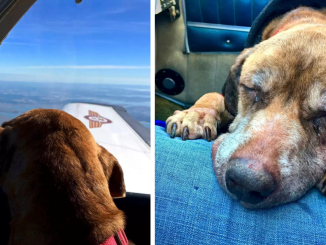
Jumping on her two hind legs, this happy poodle moves more like a kangaroo than a dog after losing her front legs in a car crash.
The pup named Cora Rose was destined for euthanasia after her legs and pelvis were shattered in the accident in Stockton, California last year.
But Zach Skow, 39, and his wife Heather, 32, rescued her from an animal shelter and paid $10,000 for life-saving medical treatment.


The determined pooch at first used a cart to get around but now spends most of her time bouncing around on her hind legs.
Mr Skow, who has four other dogs and cares for 115 through his charity Marley’s Mutts, said: ‘Of all our dogs, Cora Rose is the happiest.
‘Dogs can bounce back so quickly – she jumps, hops, all day long – she’s very strong.
‘She’s so resilient. Her quality of life is through the roof – losing her two front legs hasn’t starved her of anything.’
The couple first came across Cora Rose at the City of Stockton Animal Shelter in California, where staff were considering euthanasia after the December 2017 crash.
When they rescued Cora Rose, she had one leg in a cast and was suffering an osteo infection in the other, caused by bone protruding through the skin turning septic.

Mr Skow, who has four other dogs and cares for 115 through his charity Marley’s Mutts, said: ‘Of all our dogs, Cora Rose is the happiest’

After the operation, it took two months for the poodle to heal and then she could finally use her cart to get around
Mr Skow, who has a six-month-old daughter, said: ‘That kind of infection is like cancer for dogs.
‘The leg needed to be amputated immediately. One leg at a time had to be amputated, because she would have been under anaesthesia for too long if we had done both.
‘After surgery, she had a hard time because she still had a shattered hip and still couldn’t move properly.
‘It took two months to heal, and then she could finally use her cart to get around.’
Now, seven months after the surgery in March this year, sprightly Cora Rose is hopping around like nothing happened.
Mr Skow says Cora Rose and the other pups rescued him from alcoholism.

Now, several months after the surgery in March this year, sprightly Cora Rose is hopping around like nothing happened
He founded Marley’s Mutts in 2009 and says the animals are what helped him get sober.
Mr Skow, who also has a pig, horse and cat, said: ‘I had cirrhosis of the liver and needed a transplant.
‘My weight dropped from 183 lbs to 140 lbs, my skin was yellow and I had to use a catheter.
‘I had fantasized about ways of taking my own life. I didn’t recognize myself in the mirror. I looked like an old man.
‘One day I was weeping and crying when I looked back to see my dogs looking at me.
‘It made me realize that I was still the leader of their pack. They could still see the man inside.
‘The next day I started walking with them. Everywhere I went I had dogs with me.
‘Walking with the dogs meant I became healthy enough to undergo a liver transplant, but six months later doctors told me I didn’t even need one any more.
‘I never set out to be a dog rescuer, but they saved me.
‘Now we rescue hundreds of dogs a year. It’s the most heartwarming thing you can do.’
Mr Skow, who also has a pig, horse and cat, took in Cara Rose (pictured after the operation)Continue Reading
“Celebrating Our Senior Canine Companion: A Heartwarming Family Gathering for the Old Dog’s Birthday”

Dr. Bhavesh’s remarkable journey to establish RRSAINDIA finds its roots in his lifelong affection for animal welfare. His compassion for creatures, kindled from an early age, developed into a fervent commitment that led him to become a veterinarian.

The central focus of his career has been aiding homeless animals within his community. Recognizing the challenges these animals faced in terms of medical care, food, and shelter, Dr. Bhavesh remained steadfast in his mission to mend their physical wounds and provide them the care they deserved.

One pivotal encounter with a patient, Stuffy, unveiled the emotional dimension of animal suffering, profoundly impacting Dr. Bhavesh. Stuffy transcended being a mere patient, becoming a catalyst for a deeper, empathetic connection between him and the animals under his care.

This emotional awakening catalyzed the birth of RRSAINDIA. Dr. Bhavesh realized that holistic healing encompassed not only physical recovery but also addressing the emotional scars of these animals. The charity he founded aimed to merge physical well-being with emotional healing, promising comprehensive care for every creature in need.

RRSAINDIA swiftly became a beacon of hope for homeless animals, offering medical attention, nourishment, shelter, and most importantly, emotional succor. Dr. Bhavesh’s unwavering dedication drew others in the community to rally behind his cause, transforming countless lives in the process.

His journey encapsulates the power of empathy, dedication, and unwavering passion. The lessons learned from Stuffy ignited a revolution in Dr. Bhavesh’s approach, enriching his mission with emotional support alongside physical aid. RRSAINDIA’s inception stands as a testament to his boundless commitment to the welfare of homeless animals and a beacon of inspiration for others to follow suit.



Leave a Reply